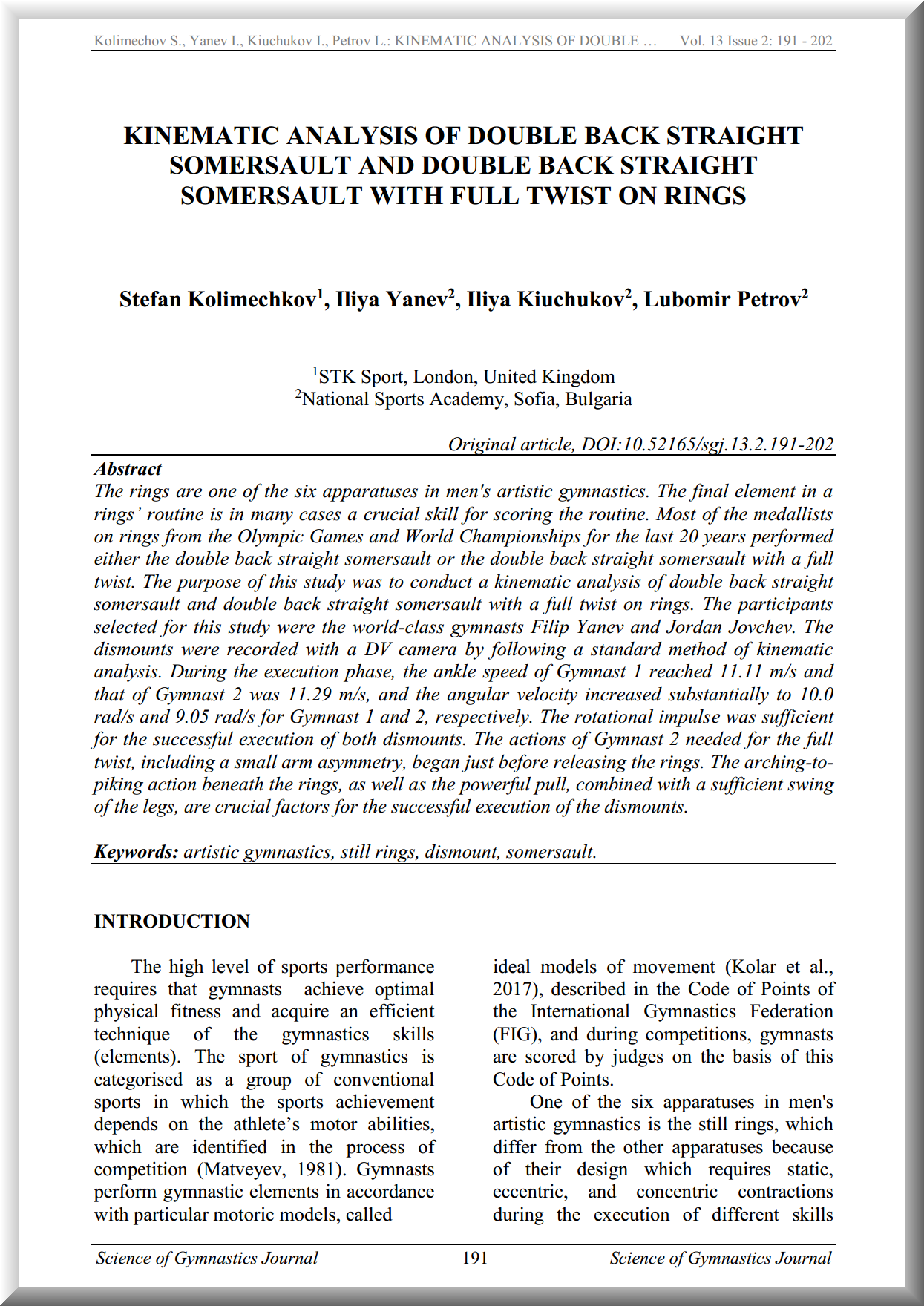Kinematic Analysis of Double Back Straight Somersault and Double Back Straight Somersault with Full Twist on Rings
Stefan Kolimechkov, Iliya Yanev, Iliya Kiuchukov, Lubomir Petrov
How to cite:
Kolimechkov, S., Yanev, I., Kiuchukov, I., Petrov, L. (2021). Kinematic analysis of double back straight somersault and double back straight somersault with full twist on rings. Science of Gymnastics Journal, 13(2), 191 - 202. DOI: https://doi.org/10.52165/sgj.13.2.191-202
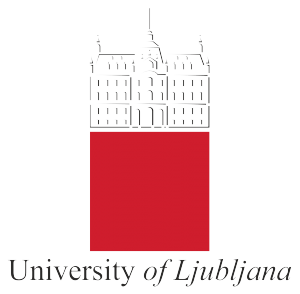
Science of Gymnastics Journal
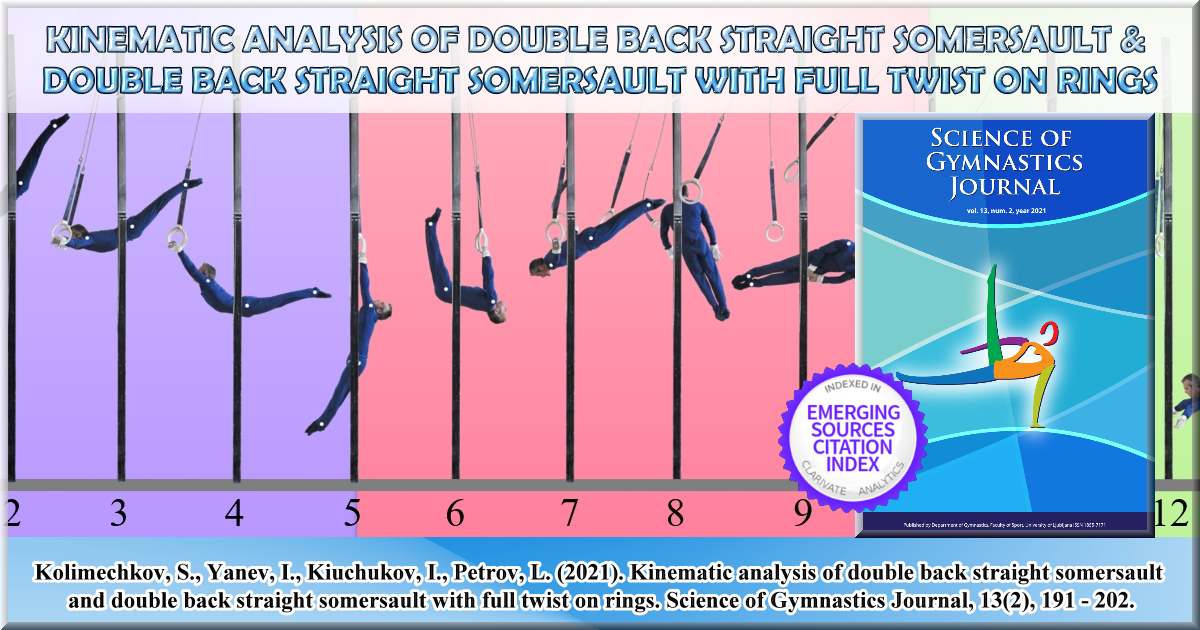
 Slovenia, Ljubljana, University of Ljubljana, Faculty of Sport, Department of Gymnastics, Gortanova 22, SI-1000
Slovenia, Ljubljana, University of Ljubljana, Faculty of Sport, Department of Gymnastics, Gortanova 22, SI-1000
e-mail: scgym@fsp.uni-lj.si | website: www.scienceofgymnastics.com
ABOUT THE JOURNAL
The Science of Gymnastics Journal (ScGYM®) is an international journal that provides a wide range of scientific information specific to gymnastics. This journal is indexed in the international database Emerging Sources Citation Index (Web of Science), as well as in Scopus, and other databases. The Science of Gymnastics Journal is supported by the International Gymnastics Federation.
ABOUT THIS ARTICLE
The data in this article is based on my Bachelor's dissertation. This study concentrated on one of the most commonly performed dismounts on Rings for the last 20 years: double back straight somersault and double back straight somersault with full twist. The study involved the two world-class gymnasts: Filip Yanev and Jordan Jovchev from the Bulgarian National Team. The first gymnasts (National Champion on Rings in 2010, Silver medallists on Vault at the 2002 European Championships, Bronze medallist on Vault at the 2004 World Cup Finals, and fifth place on Vault at the 2004 Olympic Games), performed double back straight somersault, and the second gymnasts (World Rings Champion in 2001 and 2003, Olympic Vice-Champion in 2004, took part in six consecutive Olympic Games in 1992, 1996, 2000, 2004, 2008, and 2012), who is the most successful Bulgarian gymnast (FIG, 2020), performed double back straight somersault with full twist on rings.
Kinematic Analysis of Double Back Straight Somersault and Double Back Straight Somersault with Full Twist on Rings
Published Journal Article
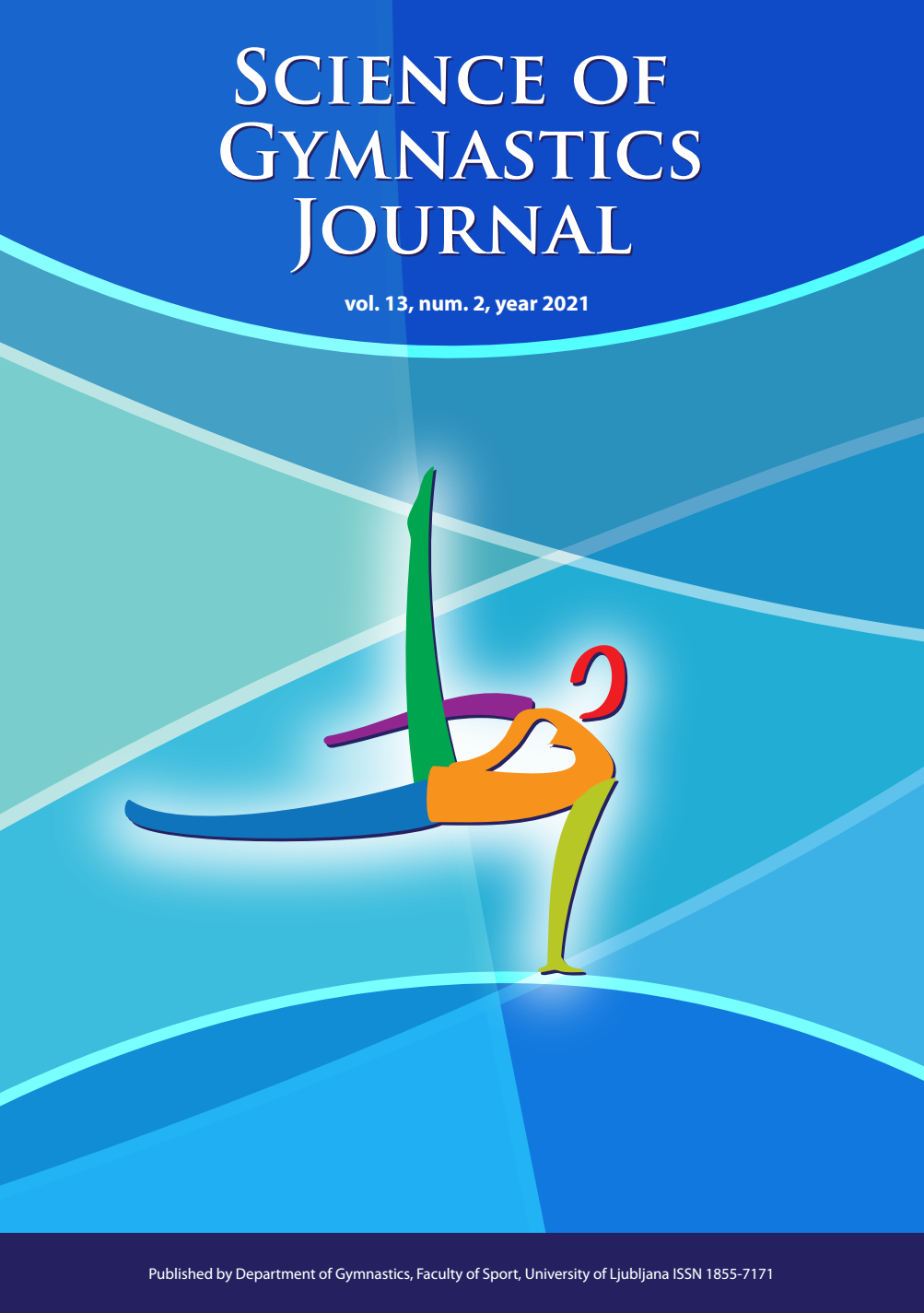
Science of Gymnastics Journal
Vol. 13, Issue 2, June 2021, pp. 191-202
KINEMATIC ANALYSIS OF DOUBLE BACK STRAIGHT SOMERSAULT AND DOUBLE BACK STRAIGHT SOMERSAULT WITH FULL TWIST ON RINGS
Stefan Kolimechkov, Iliya Yanev, Iliya Kiuchukov, Lubomir Petrov
STK SPORT, London, United Kingdom
National Sports Academy, Sofia, Bulgaria
ABSTRACT
The rings are one of the six apparatuses in the men's artistic gymnastics. The final element in a rings’ routine is in many cases a crucial skill for scoring the routine. The majority of the medallists on rings from the Olympic games and World Championships for the last 20 years, performed either the double back straight somersault or the double back straight somersault with full twist. The purpose of this study was to conduct a kinematic analysis of double back straight somersault and double back straight somersault with full twist on rings. The participants selected for this study were the two world-class gymnasts Filip Yanev and Jordan Jovchev. The dismounts were recorded with a DV camera by following a standard method of kinematic analysis. During the execution phase, the ankle speed of gymnast 1 reached 11.11 m/s and that of gymnast 2 was 11.29 m/s, and the angular velocity increased substantially to 10.0 rad/s and 9.05 rad/s for gymnast 1 and 2, respectively. The rotational impulse was sufficient for the successful execution of both dismounts. The actions of gymnast 2 needed for the full twist, including a small arm asymmetry, began just before releasing the rings. The arching-to-piking action beneath the rings, as well as the powerful pull, combined with a sufficient swing of the legs are crucial factors for the successful execution of the dismounts.
Keywords: artistic gymnastics, still rings, dismount, somersault.
INTRODUCTION
The high level of sport performance requires the gymnasts to achieve optimal physical fitness and acquire an efficient technique of the gymnastics skills (elements). The sport of gymnastics is categorised in a group of conventional sports in which the sports achievement depends on the athlete’s own motor abilities, which are identified in the process of a competition (Matveyev, 1981). Gymnasts perform gymnastics elements in accordance with particular motoric models, called ideal models of movement (Kolar et al., 2017), which are described in the Code of Points of the International Gymnastics Federation (FIG), and during competitions, gymnasts are scored by judges, based on this Code of Points.
One of the six apparatuses in the men's artistic gymnastics is the still rings, which differ from the other apparatuses because of its design, that requires static, eccentric and concentric contractions during the execution of different skills (Gorosito, 2013). At the beginning, the design of the rings was triangular with a straight part for the handgrip, and then it was changed to circular, which has been in use for more than 100 years. Although predominantly for recreational and school gymnastics, new anatomic bent rings design was also proposed, which seems to preserve good kinaesthetic awareness of the hand grip (Pušnik, Čuk, & Hadžič, 2017). The rings can move freely in all directions, and this adds tremendous instability to the elements, which makes them more difficult and different from the technique of the other apparatuses (Sommer, 2008). The difficulty comes from the fact that gymnasts must pay attention to the movements of the individual parts of their body, as well as to the deviation of the rings. In recent years, static elements have contributed to the development of the rings, and this requires significantly greater capabilities of upper body strength. The modern performance on the rings consists of swing elements, strength elements and transitions between swing and strength elements or vice versa in approximately equal amounts (FIG, 2017).
Gymnastics provides almost limitless possibilities for biomechanical research, and consequently with its large number of elements, would require very many studies (Prassas, Kwon, & Sands, 2006). The elements performed on the gymnastics rings are difficult to analyse, and studies have been concentrated on strength elements (Bango, Sillero-Quintana, & Grande, 2013; Gorosito, 2013; Hübner & Schärer, 2015; Schärer & Hübner, 2016) or swing elements (Brewin, Yeadon, & Kerwin, 2000; Sprigings, Lanovaz, Watson, & Russell, 1998), but less research has been published on rings dismounts (Yeadon, 1994; Zou, Gong , Wang , & Wu, 2012). The final element in a rings’ routine (the dismount) is in many cases a crucial skill for scoring the routine. The majority of all 62 medallists on rings (75%) between 2000 and 2019 from the Olympic games and World Championships, performed either the double back straight somersault or the double back straight somersault with full twist. Five Olympiads were held during this period: Sydney 2000, Athens 2004, Beijing 2008, London 2012, and Rio 2016 (FIG, 2019). The Olympic rings medallists performed either the double back straight somersault (26.7%, 4 gymnasts) or the double back straight somersault with full twist (46.7%, 7 gymnasts) or with double twist (13.3%, 2 gymnasts), Figure 1. Only 2 out of the 15 Olympic rings medallists for the last 5 Olympiads performed a different dismount.
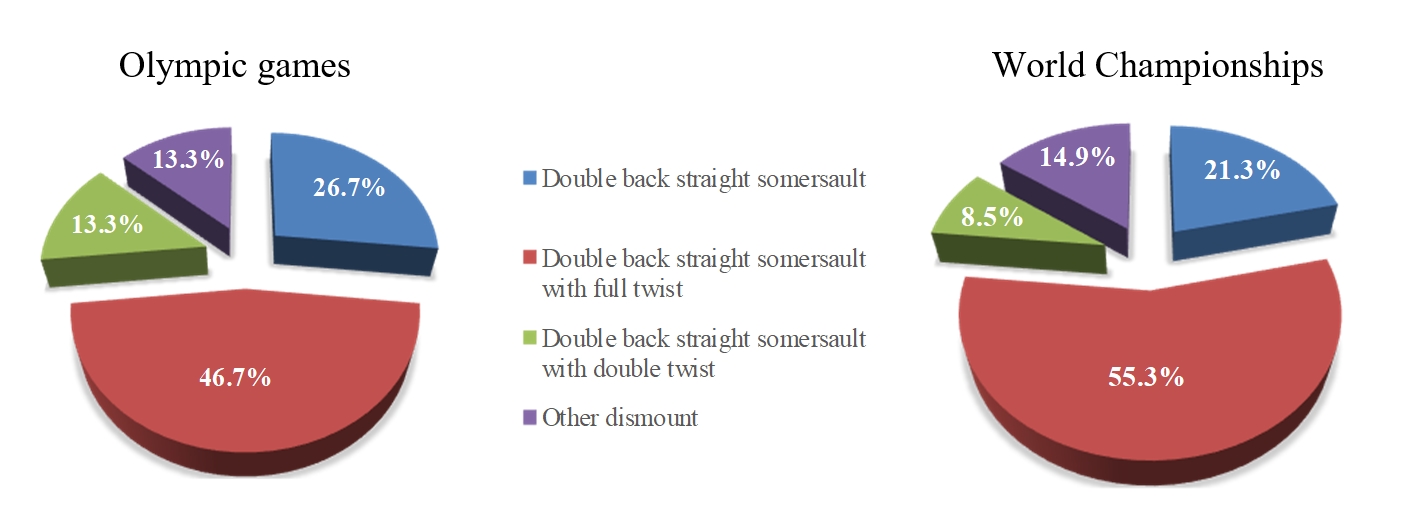
Figure 1. Percentage of the dismounts performed on rings by the medallists from Olympic Games and World Championships for the last 20 years (2000-2019)
Fifteen World Championships were also held during the last two decades: Ghent 2001, Debrecen 2002, Anaheim 2003, Melbourne 2005, Aarhus 2006, Stuttgart 2007, London 2009, Rotterdam 2010, Tokyo 2011, Antwerp 2013, Nanning 2014, Glasgow 2015, Montreal 2017, Doha 2018, and Stuttgart 2019 (FIG, 2019). Forty (85.1%) out of the all forty-seven World rings medallists performed one of the following dismounts: double back straight somersault (21.3%, 10 gymnasts), double back straight somersault with full twist (55.3%, 26 gymnasts) or with double twist (8.5%, 4 gymnasts), Figure 1. The most common dismount performed by the Olympic and World rings medallists for the last 20 years is the double back straight somersault with full twist. Analysing such elements and providing methodological progressions for their attainment can greatly improve the training process, in addition to providing room for learning more difficult variations. Therefore, the purpose of this study was to conduct a kinematic analysis of double back straight somersault and double back straight somersault with full twist on rings, concentrating on the descending and releasing part of the dismounts.
METHODS
The study was performed in accordance with the Declaration of Helsinki for Human Research (WMA, 2013), and an informed consent was obtained from the participants.
The participants selected for this study were the two world-class gymnasts: Filip Yanev (gymnast 1, stature 1.69 m; body mass 62 kg) and Jordan Jovchev (gymnast 2, stature 1.63 m; body mass 62 kg) from the Bulgarian National Team. The first gymnasts (National Champion on Rings in 2010, Silver medallists on Vault at the 2002 European Championships, Bronze medallist on Vault at the 2004 World Cup Finals, and fifth place on Vault at the 2004 Olympic Games), performed double back straight somersault, and the second gymnasts (World Rings Champion in 2001 and 2003, Olympic Vice-Champion in 2004, took part in six consecutive Olympic Games in 1992, 1996, 2000, 2004, 2008, and 2012), who is the most successful Bulgarian gymnast (FIG, 2020) performed double back straight somersault with full twist on rings.
The dismounts on the rings were recorded in training conditions, in Sofia, Bulgaria, with a DV camera (50 Hz) by following a standard method of kinematic analysis by using Ariel Performance Analysis System (APAS). А rectangular frame with dimensions 5 x 3 m was used for space calibration, and 24 markers were added on each 1 m (x, y). The left foot, knee, hip, shoulder, and elbow joints; the hand, the top of the head, and a point on the frame of the rings were digitalised. Handstand was selected as beginning, and stable landing position as an end of the elements. The raw data was transformed into 2D with direct linear transformation and smoothed with a cut-off frequency of 7 Hz before being submitted to further analysis. The path (trajectory) of the main joints (shoulders, hips and ankles) was determined. Linear velocity of shoulder, hip, and ankle joints was calculated. The angular velocity (ω) of the body (ω of the line between CG of upper and CG of lower body parts) was calculated only on the transverse axis (axis of rotation of the somersaults). Graphics sequence for each dismount was produced, in which the selected poses (every 5th frame) were numbered sequentially. Additionally, the calculated parameters and variables of the two elements were compared in order to provide methodological recommendations for learning double back straight somersault and progressing towards double back straight somersault with full twist on the rings.
RESULTS
The dismounts double back straight somersault (difficulty score of 0.3) and double back straight somersault with full twist (difficulty score of 0.4) on rings are both from Group IV (Dismounts) as described in the Code of Points by FIG for the 2017-2020 Olympic cycle (FIG, 2017). Each fifth frame from the performances of both dismounts in training conditions is presented in Figure 2.
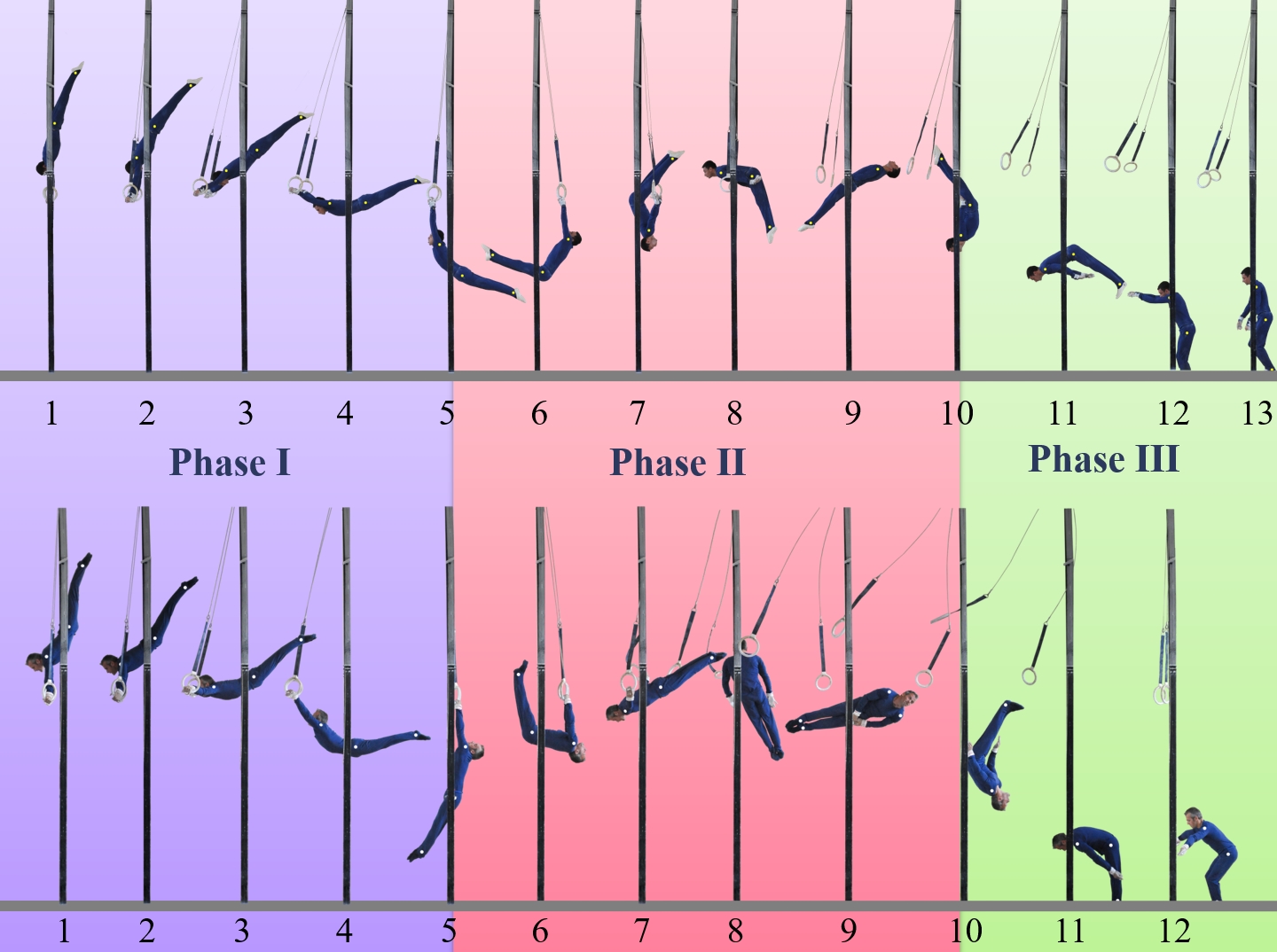
Figure 2. Graphics sequence of double back straight somersault (gymnast 1) and double back straight somersault with full twist (gymnast 2) on rings
Both elements were divided into three phases (Preparatory Phase - I, Execution Phase - II, and Landing Phase – III). The linear velocity of shoulder, hip, and ankle joints throughout both dismounts is shown in Figure 3.
In the first phase (descending phase), the actions of gymnasts 1 and gymnast 2 are very similar. This phase represents a bail from handstand similar to a backward longswing. In both cases, the preparatory phase starts from a handstand and continues to pose 5 / frame 25 (Figure 2). The gymnasts push the rings forward, which brings their body out of balance. Legs are leading the move with a slight pike position in the hips (pose 2 / frame 10, Figure 2) of gymnast 1. Gymnast 2 performs the action in the same way, but without noticeable flexion in the hip joints. However, the second gymnast has a slight angle in the shoulder joints with his head out (pose 2 / frame 10, Figure 2). Arms are parallel and fully extended in the elbow joints, and head remains slightly raised. Unlike gymnast 1, the second gymnast opens the rings sideways, then he narrows them back and pushes them forward. Thus, the bail continues to about 30 degrees above the horizontal line of the rings. After that, the gymnasts turn the rings slightly outwards followed by bending their body backwards when passing the level of the rings. The shoulders and chest become the leading parts of the movement, while legs are significantly behind (pose 4 / frame 20, Fig. 2). The head remains slightly raised and both gymnasts continue in that position until their shoulders and chest reach hanging position, seeking to maximally extend the shoulder joints. This marks the end of the preparatory phase.
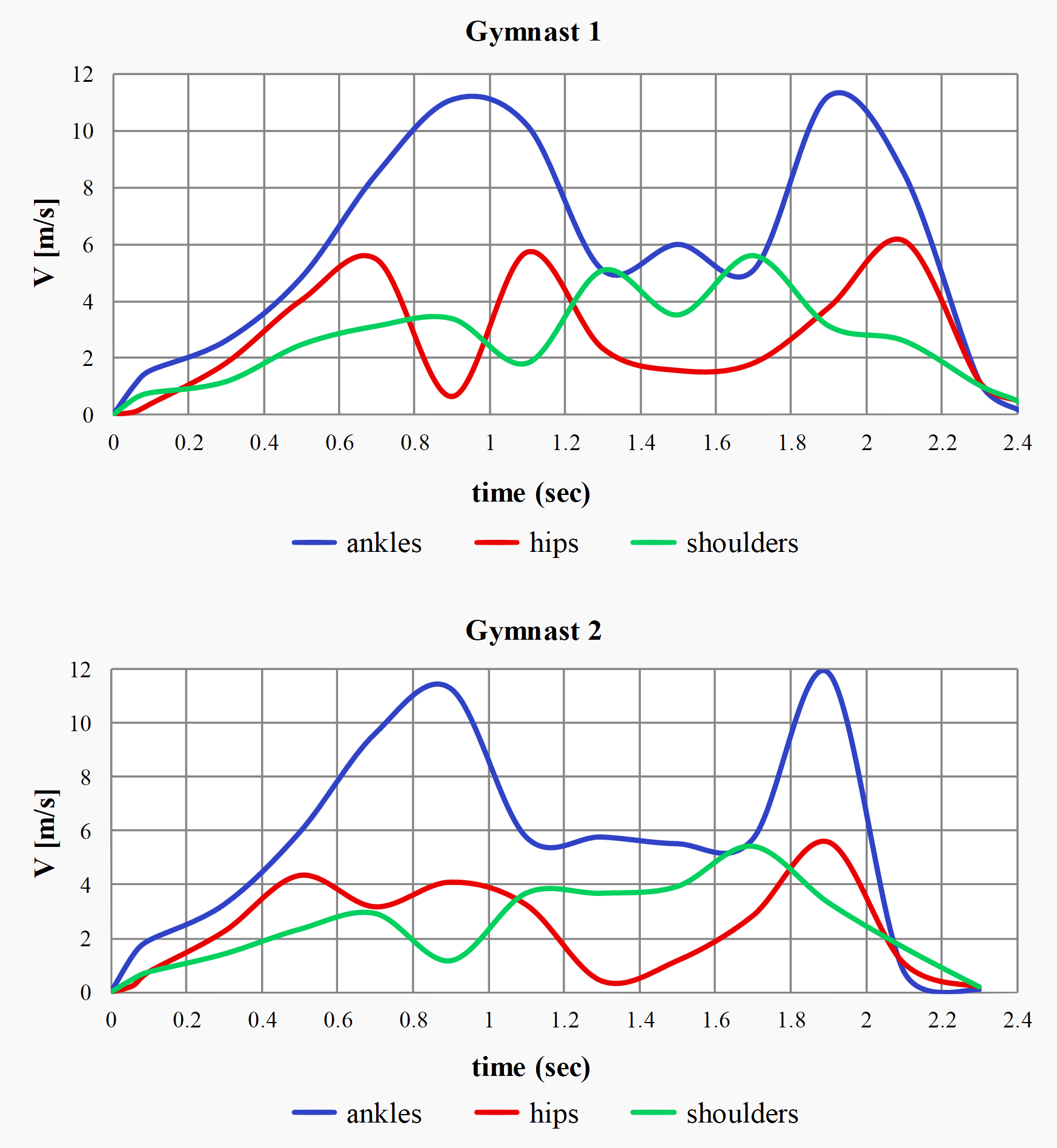
Figure 3. Linear velocity of shoulder, hip, and ankle joints during double back straight somersault (gymnast 1) and double back straight somersault with full twist (gymnast 2) on rings
The second phase (execution phase) begins with an active flexion move of the hips, in which the ankle speed of gymnast 1 reaches 11.11 m/s and that of gymnast 2 is 11.29 m/s (Figure 3 and Figure 5). At this point, the angular velocity increases its value substantially and reaches 10.0 rad/s and 9.05 rad/s for gymnast 1 and 2, respectively (Figure 4). The legs perform a powerful swing forward and upward after passing the vertical beneath the rings. The body flexes in the hip joints nearly to 90 degrees and the shoulder angle is decreasing in both dismounts. This position is maintained until the knees are in line with the hand grasp of the gymnasts. After that, the arms are moving sideways (casting the rings) and gymnast 1 releases the rings without changes in his body position (pose 7 / frame 35, gymnast 1, Figure 2) while gymnast 2 fully extends his body (pose 7 / frame 35, gymnast 1, Figure 2). The different actions which are observed at the end of releasing the rings lead to some differences in the angular velocity of the gymnasts. The angular velocity of gymnast 2 decreases slightly due to his fully extended position, while gymnast 1 retains high values because of the configuration of his body, which remains slightly folded (Figure 4 and Figure 5).
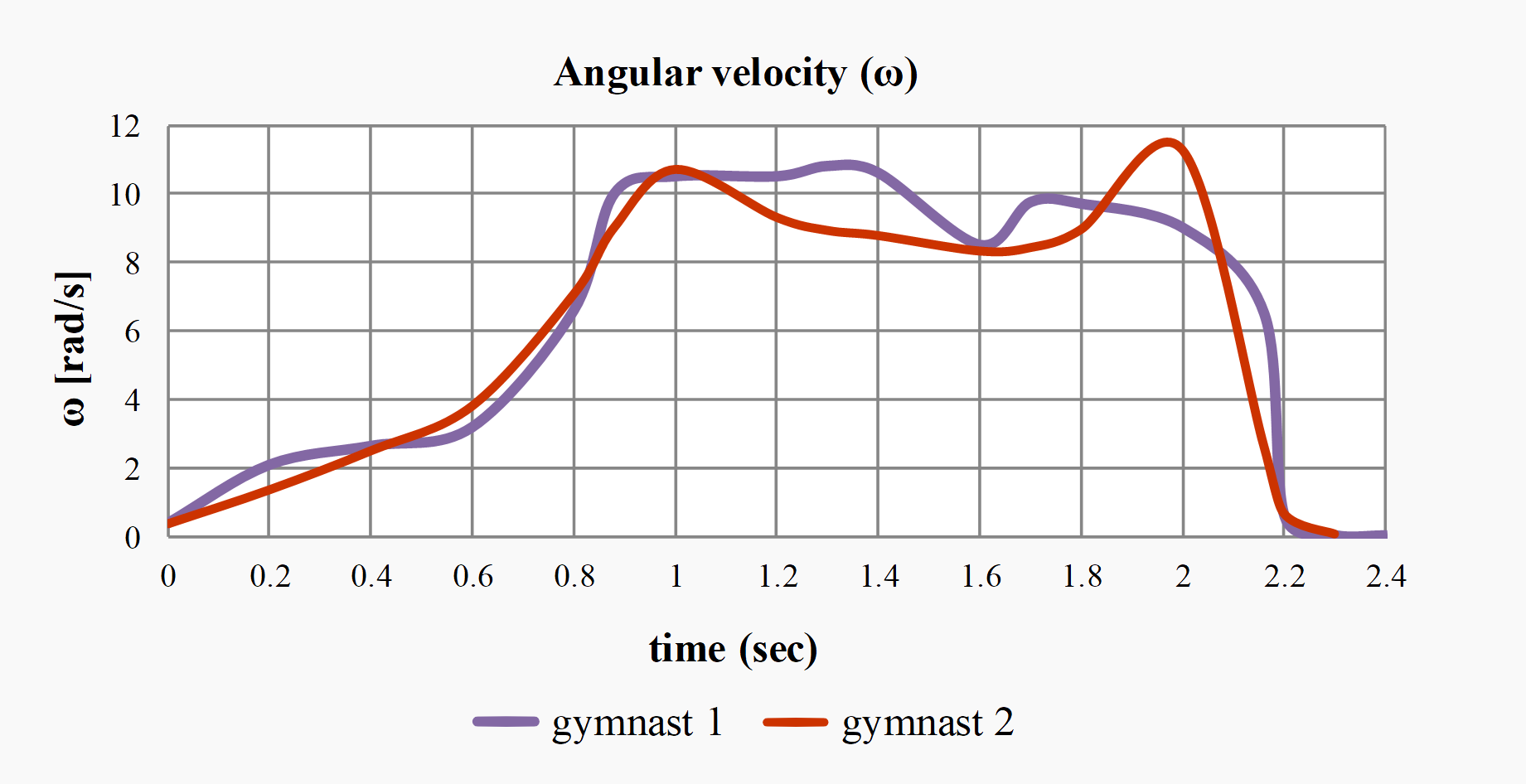
Figure 4. Angular velocity on the transverse axis (the axis of rotation of the somersaults) of double back straight somersault (gymnast 1) and double back straight somersault with full twist (gymnast 2) on rings
The flexion action in the hip joints of gymnast 1 after crossing hanging position is more visible, which results in different speed of the hip and shoulder joints of both gymnasts. A greater amplitude in the velocity curve at the hip joints is observed in gymnast 1. The second gymnast releases the rings later, and as a result of slight asymmetrical action of his arms at this moment (Figure 5), the body rotates around the longitudinal axis in the flight phase. Gymnast 1 remains flexed in his hips with his arms down and sideways until the end of the first somersault, whilst gymnast 2 shows straight posture throughout the entire phase, and begins twisting along the longitudinal axis immediately after releasing the rings. Both gymnasts have their centre of mass located at the height of the rings, which indicates the correct performance in pose 8 / frame 40 (for gymnast 1) and pose 7 / frame 35 (for gymnast 2) on Figure 2. Gymnast 1 unfolds his body with an active movement of his head and shoulders while his legs slow down, and these actions are visible especially after his shoulders pass between the ring cables in pose 9 / frame 45, Figure 2. The angular velocity decreases slightly due to the straightening of his body, which is followed by an overextension, and as a result, the speed of rotation increases slightly again (Figure 5). Thus, gymnast 1 executes ¾ of the second somersault. Gymnast 2 executes the second somersault with fully-stretched body, his head slightly turns towards the direction of the twist and his arms remain down. Thus, the gymnast performs a complete 360° twist and ¾ of the second somersault.
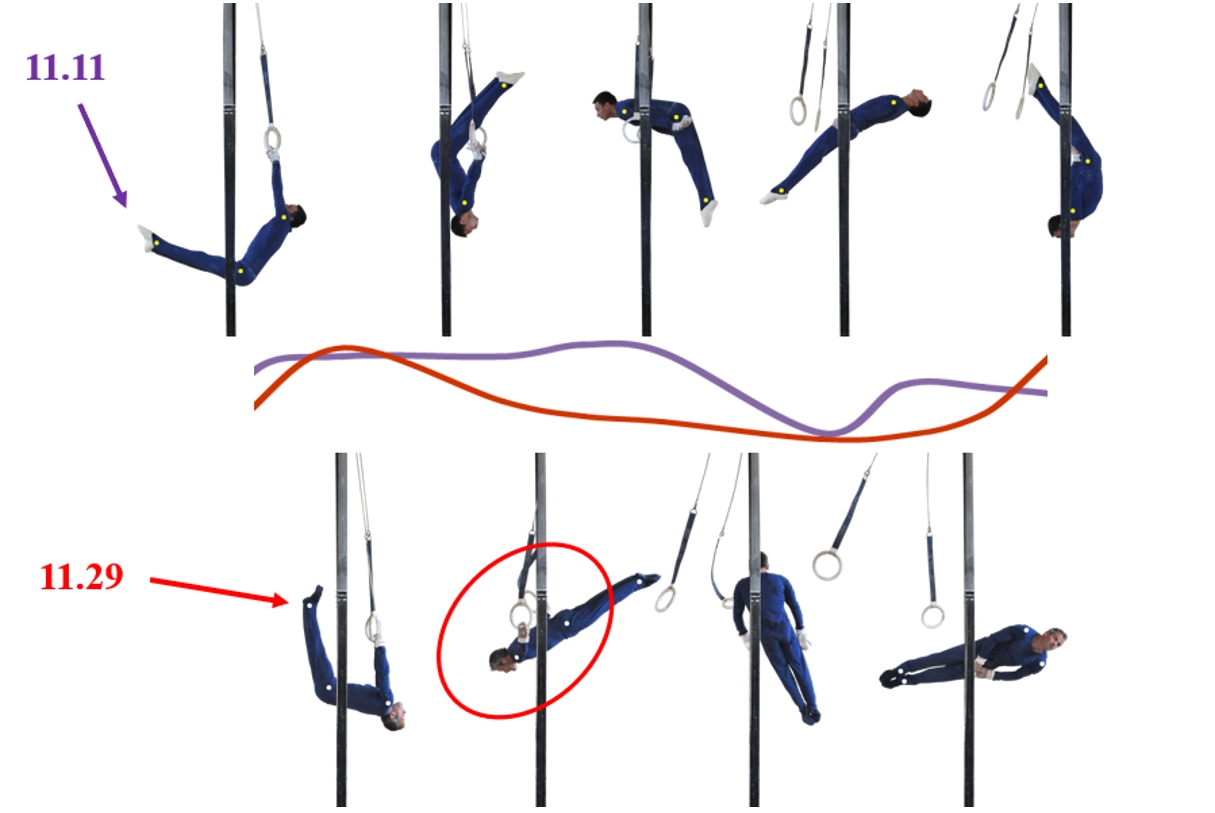
Figure 5. Actions during the execution phase of the dismounts, in addition to dynamics of angular velocity for gymnast 1 (purple) and gymnast 2 (red). The numbers show the peak linear ankle speed for gymnast 1 (11.11 m/s) and gymnast 2 (11.29 m/s)
During the third phase (landing), the actions of both gymnasts are identical. In this phase of the two dismounts, the legs accelerate to reach the ground and ensure a stable landing. Due to the active flexion in the hips, the angular velocity of gymnast 2 increases more than that of gymnast 1 at the end of the flight phase. Both gymnasts show hips flexion in pose 11 / frame 55 for gymnast 1 and pose 10 / frame 50 for gymnast 2 (Figure 2), and land on the mat by amortization in the knee joints (pose 12 / frame 60 in both dismounts, Figure 2), so that the legs bend until the body is in a half-squat landing position.
DISCUSSION
As it was shown on Figure 1, the most performed dismount by the Olympic and World rings medallists for the last 20 years is the double back straight somersault with full twist, followed by the double back straight somersault. It is of particular interest for this study that in the period from 2000 to 2005, the Bulgarian gymnast Jordan Jovchev (gymnast 2 in our study) was the only person out of all medallists on rings at the World Championships and Olympic Games for that period, who was performing the double back straight somersault with full twist, while the other medallists were performing its easier version without turning along the longitudinal axis of the body.
Artistic gymnasts have to overcome their own weight, and in many cases their body mass is multiplied several times when tumbling and dismounting (Jemni, 2018). It has been shown that during performances of backward giant swing by elite artistic gymnasts, the peak combined tension measured in the rings cables reaches 9 bodyweights (Nissinen, 1983). This tension occurs as the gymnast passes through the bottom of the swing, which is also evident during dismounts. Research suggested that such tension increases the risk of ligament and muscular damages and causes increased pain in the shoulder joints (Caraffa et al., 1996). Subsequently, a number of studies were concentrated on the minimising peak force at the shoulders during a backward longswing (Brewin et al., 2000; Yeadon & Brewin, 2003), providing simulation models for a better control of the longswing and handstand (Yamada, Watanabe, Kiguchi, & Izumi, 2002), as well as an indirect video-based method for estimating combined cable tension throughout movements on rings (Brewin & Kerwin, 2003). In contrast with gymnast 1, gymnast 2 from our study opens his arms laterally in the first phase of the dismount, a technique, which in our opinion accumulates less energy (Figure 6). When arms are too open laterally at the descending phase, the distance between the centre of gravity and the point of the external force, which acts on the grip of the gymnast, is shorter. This is a prerequisite for the accumulation of less torque in relation to the center of gravity. However, based on our eye observations, as a result of more powerful leg swing, as well as his active hand action, a large rotational impulse is provided, which increases the speed and peak force, and it is sufficient for the flight phase. Brewin et al. demonstrated that the arching-to-piking aspect of the gymnasts’ technique is the main way to limit the peak shoulder forces to a tolerable level, but the role of lateral arm movements during the descending may also minimise the shoulder force experienced by the gymnasts (Brewin et al., 2000), and, therefore, reduce the risk of damage in ligaments and muscles. Additionally, when a gymnast descends from a handstand, the bending (arching) of the body must be within certain degrees, because excessive bending will reduce the effect of the bail (the descending). To a large extent, these body movements depend on the individual capabilities of the gymnast.
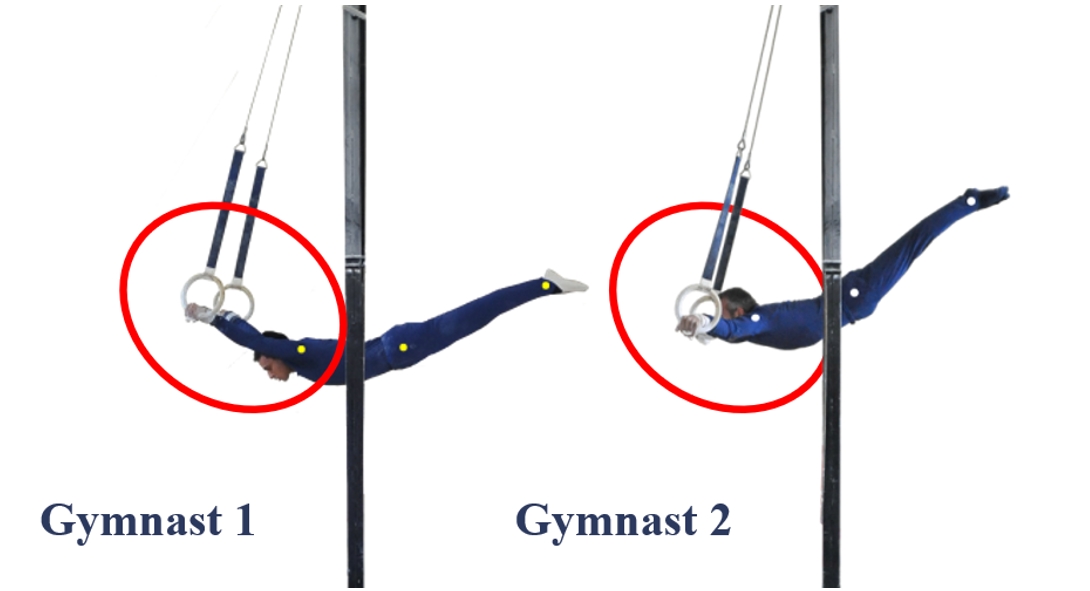
Figure 6. Differences in the technique of both gymnast during the first phase of the dismount.
Zou et al. published a study on the kinematic characteristics of Yan Mingyong's dismount on rings in 2012 (Zou et al., 2012). The Chinese gymnast, who won a gold medal on rings at the 2009 World Gymnastics Championships in London (FIG, 2019), performed the double back straight somersault with full twist for 2.48 sec, and that is similar to gymnast 2 from our study, Jordan Jovchev (2.3 sec). Moreover, the technique photographed by Zou et al. (Figure 7), and applied by Yan Mingyong at the descending phase seems to be similar to the one used by Jordan Jovchev (gymnast 2 from our study), in which the arms of the gymnasts move laterally in contrast with gymnast 1, who keeps his arms parallel by pushing the rings forward.
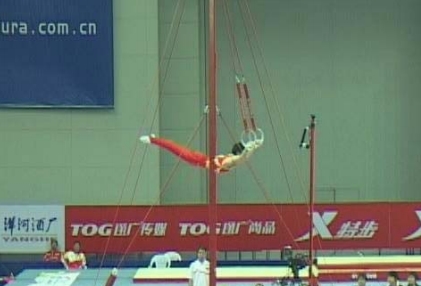
Figure 7. Yan Mingyong’s technique during the first phase of the dismount (Zou et al., 2012)
Furthermore, similar to the gymnasts from our study, the kinematic analyse of Yan Mingyong's dismount showed that his shoulder and hip angles decreases greatly when swinging beneath the rings. In addition to that, when releasing the rings, both Jordan Jovchev and Yan Mingyong keep a straight body with their hands close to the body in order to speed up the rotation needed for the twist around the longitudinal axes. In our study, it was observed that Jordan Jovchev uses asymmetrical arm action to initiate twist (Figure 5). When studying twisting techniques applied in dismount from rings, Yeadon concluded that even a small arm asymmetry was sufficient to establish the direction of twist, and observed that most gymnasts applied asymmetrical arm action in order to initiate twists (Yeadon, 1994).
Methodological progressions
We recommend that gymnasts should achieve certain characteristics of the double straight somersault, such as height and rotational movement, before performing rotations (twists) around the longitudinal axis. Both dismounts on the rings discussed in our study require a good technical foundation before starting learning them. That includes the execution of a well-balanced handstand and backward longswing (giant swing) to, as well as through a handstand. Gymnasts should also be able to execute double back somersaults in a tuck, pike and/or open tuck position with ease. Teaching progressions should follow basic pedagogic principles, so that each progressive step include a movement structure similar to the desired element (Kolar, Kolar, & Stuhec, 2002). Gymnasts have to show a stable handstand with a minimum swing of the rings at the start of the execution of the dismounts. The methodological progressions can follow these steps:
- Double back pike somersault with emphasis on the moment of the release of the rings (the position of the body in relation to the rings);
- Double back straight somersault into a foam filled dismount pit;
- Double back straight somersault onto soft mats (at ground level) in a dismount pit;
- Double back straight somersault onto soft mats (10 cm above the ground level) in a dismount pit;
- Double back straight somersault onto soft mats (20 cm above the ground level) in a dismount pit;
- Double back straight somersault with emphasis on the body shape in real conditions;
- Double back straight somersault with half twist into a dismount pit;
- Double back straight somersault with full twist into a dismount pit;
- Double back straight somersault with full twist onto soft mats (at ground level) in a dismount pit;
- Double back straight somersault with full twist onto soft mats (10 cm above the ground level) in a dismount pit;
- Double back straight somersault with full twist onto soft mats (20 cm above the ground level) in a dismount pit;
- Double back straight somersault with full twist in real conditions.
The amplitude of the arching-to-piking action, as well as the powerful pull, combined with a strong swing of the legs are crucial factors for the successful performance of the elements discussed in our study. In airborne rotational elements, including rings dismounts, the gymnast rotates around his centre of mass, so it is particularly important to control the somersaulting or twisting angular momentum. Prassas et al. pay attention that during the flight part, the total angular momentum remains constant, so altering the speed of rotation is possible by changing body configuration (Prassas et al., 2006). An insufficient swing beneath the rings in which the centre of mass of the gymnast is below the level of the rings, will lead to an incomplete rotation of the double straight somersaults. The actions applied for the full twist around the longitudinal axis by gymnast 2 in our study begins just before releasing the rings.
CONCLUSIONS
Both gymnasts in this study completed successfully their dismount on the rings. The rotational impulse was sufficient for the successful execution of both, the double back straight somersault and double back straight somersault with full twist. The sufficient arching-to-piking action beneath the rings, as well as the powerful pull of the rings are crucial factors for the successful execution of the dismounts. The twist around the longitudinal axes is initiated by a slight asymmetrical action of the arms of the gymnast.
REFERENCES
Bango, B., Sillero-Quintana, M., & Grande, I. (2013). New tool to assess the force production in the swallow. Science of Gymnastics Journal, 5(3), 47 - 58.
Brewin, M., & Kerwin, D. (2003). Indirect estimation of cable tension during gymnastic movements on rings. Sports Engineering, 6, 177–185.
Brewin, M., Yeadon, M., & Kerwin, D. (2000). Minimising peak forces at the shoulders during backward longswings on rings. Human Movement Science, 19, 717-736.
Caraffa, A., Cerulli, G., Rizzo, A., Buompadre, V., Appoggetti, S., & Fortuna, M. (1996). An arthroscopic and electromyographic study of painful shoulders in elite gymnasts. Knee Surg Sports Traumatol Arthrosc, 4(1), 39-42. doi: 10.1007/BF01565996
FIG. (2017). Code of Points 2017-2020 for Men's Artistic Gymnastics Competitions.
FIG. (2019). International Gymnastics Federation - Results. Retrieved 3 June, 2020, from https://www.gymnastics.sport/site/events/searchresults.php
FIG. (2020). Sports Profile of Jordan Jovchev at the International Gymnastics Federation (FIG). Retrieved 02.06.2020, from https://gymnastics.sport/site/athletes/bio_detail.php?id=5693&type=licence
Gorosito, M. (2013). Relative strength requirement for swallow element proper execution: a predictive test. Science of Gymnastics Journal, 5(3), 59 - 67.
Hübner, K., & Schärer, C. (2015). Relationship between swallow, support scale and iron cross on rings and their specific preconditioning strengthening exercises. Science of Gymnastics Journal, 7(3), 59 - 68.
Jemni, M. (2018). The Science of Gymnastics - Advanced Concepts (2nd ed.). Routledge, Taylor & Francis Grp. London and New York. ISBN: eBook 9781315203805, Paperback 9781138701939; https://www.routledge.com/The-Science-of-Gymnastics-Advanced-Concepts/Jemni/p/book/9781138701939.
Kolar, E., Kolar, K. A., & Stuhec, S. (2002). Comparative analysis of selected biomechanic characteristics between a support backward swing and support swing for the 1 1/4 straddle-piked forward salto on the parallel bars. Sports Biomech, 1(1), 69-78. doi: 10.1080/14763140208522787
Kolar, E., Piletič, S., Bedenik, K., Pavletič, S., Štuhec, S., & Veličković, S. (2017). Kinematic analysis of the new element 'Dimic' and its comparison with 'Bilozerchev' on Parallel bars Science of Gymnastics Journal, 9(1), 83-96.
Matveyev, L. (1981). Fundamentals of Sports Training. Moscow.
Nissinen, M. A. (1983). Kinematic and kinetic analysis of the giant swing on rings. In H. Matsui & K. Kobayashi, . (Eds.), Biomechanics VIII-B (pp. 781-786): Human Kinetics.
Prassas, S., Kwon, Y. H., & Sands, W. A. (2006). Biomechanical research in artistic gymnastics: a review. Sports Biomech, 5(2), 261-291. doi: 10.1080/14763140608522878
Pušnik, I., Čuk, I., & Hadžič, V. (2017). Influence of a new anatomic ring design on palm skin temperature. Science of Gymnastics Journal, 9(1), 61 - 70.
Schärer, C., & Hübner, K. (2016). Accuracy of prediction of maximum resistance at increased holding times based on a three seconds maximum static strength test of the three main strength elements on rings. Science of Gymnastics Journal, 8(2), 125 - 134.
Sommer, C. (2008). Building the Gymnastic Body - The Science of Gymnastics Strength Training. USA: Olympic Bodies, LLC.
Sprigings, E. J., Lanovaz, J. L., Watson, L. G., & Russell, K. W. (1998). Removing swing from a handstand on rings using a properly timed backward giant circle: a simulation solution. J Biomech, 31(1), 27-35. doi: 10.1016/s0021-9290(97)00110-3
WMA. (2013). WMA Declaration of Helsinki - Ethical Principles for Medical Research Involving Human Subjects.
Yamada, T., Watanabe, K., Kiguchi, K., & Izumi, K. (2002). Control for a rings gymnastic robot using fuzzy reasoning and genetic algorithms. Artif Life Robotics, 6, 113-119.
Yeadon, M. (1994). Twisting techniques used in dismounts from rings. Journal of Applied Biomechanics, 10, 178-188.
Yeadon, M., & Brewin, M. (2003). Optimised performance of the backward longswing on rings. J Biomech, 36, 545-552.
Zou, N., Gong , M., Wang , L., & Wu, J. (2012). A Kinematic Analysis of Yan Mingyong's landing from Rings after the backward giant swing tuck of 2-circle back flip and a 360° turn. Paper presented at the 2012 International Conference on Systems and Informatics (ICSAI 2012)
Full Text: Kinematic Analysis of Double Back Straight Somersault and Double Back Straight Somersault with Full Twist on Rings. Science of Gymnastics Journal
Available on the official website of the Journal
This article is also available on ResearchGate
Authors
Stefan Kolimechkov PhD
Department of Physiology and Biochemistry, National Sports Academy, Sofia, Bulgaria
Academia.edu | ORCID | Research Gate | Google Scholar
Assistant Professor Iliya Yanev PhD
Department of Gymnastics, National Sports Academy, Sofia, Bulgaria
Research Gate | Google Scholar
Associate Professor Iliya Kiuchukov PhD
Department of Gymnastics, National Sports Academy, Sofia, Bulgaria
Associate Professor Dr Lubomir Petrov PhD
Department of Physiology and Biochemistry, National Sports Academy, Sofia, Bulgaria
Academia.edu | ORCID | Research Gate | Google Scholar
Corresponding author: e-mail: dr.stefan.kolimechkov@gmail.com
DOI: 10.52165/sgj.13.2.191-202
How to cite this article:
Kolimechkov, S., Yanev, I., Kiuchukov, I., Petrov, L. (2021). Kinematic analysis of double back straight somersault and double back straight somersault with full twist on rings. Science of Gymnastics Journal, 13(2), 191 - 202. DOI: https://doi.org/10.52165/sgj.13.2.191-202
